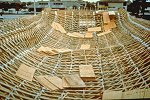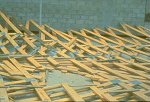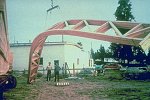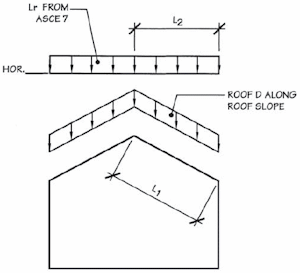L, L0, Lr - live loads related to use/occupancy of structure (italics L stands for span length)
ASCE 7 table 4-1 (2 pages), IBC table 1607.1 (2 pages)
contractor must ensure construction loads don't exceed capacity
trussnet
reductions
If a member has a small area contributing live load, it is likely that a fairly high unit live load will be imposed over that relatively small area. On the other hand, as the area contributing live load become large, it is less likely that this large area will be uniformly loaded by the same high unit load considered in the design of a member with small area. high unit loads are likely to occur over small areas, but not large areas
situations with no reduction
- L > 100 psf
- public assembly
- parking garages
floor live loads
30-250 psf
use influence area
small influence area < 400 sqft
alternate concentrated loads
IBC sec. 1607.4, IBC sec. 1607.9.2, NDS sec. 15.1 (for vehicle traffic)
use the type that produces the most critical condition in load combinations (sec. 2.17) is to be used
non-vehicle loads 2.5 ft x 2.5 ft vehicle loads 4.5 in. x 4.5 in.
partition live load
ASCE 7 sec. 4.2.2, IBC sec. 1607.5
+15 psf minimum if L < 80 psf (no reduction)
roof live loads Lr
roofing, reroofing, equipment installation and servicing, fire-fighting equipment
ASCE 7 sec. 4.2 and sec. 4.9, IBC sec. 1607.11
use tributary area
20 psf with reduction for AT > 200 sqft and slopes F > 4 in./ft
ASCE 7 and IBC values are on horizontal plane
special live loads
IBC 1607.7 Loads on handrails, guards, grab bars and vehicle barriers
IBC 1607.8 Impact loads
IBC 1607.12 Crane loads
etc



